Last Updated on April 13, 2025 by Kittredge Cherry
“And during supper… one of his disciples, whom Jesus loved, was lying close to the breast of Jesus.” — John 13:2, 23 (RSV)
Friends get together for an intimate dinner in “The Last Supper” from “The Passion of Christ: A Gay Vision,” a series of 24 paintings by Douglas Blanchard. “The Last Supper” appears on the cover of a new edition of the Passion book released in August 2021.
The contemporary Christ figure dines with twelve people, the classic dozen disciples, but they are a multi-racial group of many ages, orientations, and gender identities. An elderly black woman sits beside a white businessman. A drag queen in high heels holds hands with a man. The face of Jesus looks almost the same as when he was preaching in the temple… impassive. He wraps his arms around the men beside him. The whole group is joined by touch, and yet they are not completely united. They express emotions ranging from surprise to sorrow, and each one looks in a different direction. Plates hold food for a Passover Seder meal, including matzo bread, a hard-boiled egg, and roast lamb. A single glass of blood-red wine stands out against the drab colors, hinting at the sacrifice to come. The room is simple, lit only by a bare light bulb. They are seated in a way that invites viewers to join them at the table.
 All four gospels describe the final meal that Jesus ate with his disciples before he was arrested. Biblical accounts of the Last Supper are full of dramatic details and dialogue, making it possible to imagine what happened on that fateful night. Jesus announced to his startled disciples that one of them would betray him. They were shocked again when he identified the bread and wine as his own body and blood, urging them to eat and drink their share of it. By giving new meaning to the Passover meal, he helped prepare them for his impending death He summarized his teachings on love and gave them a new commandment: Love each other as I have loved you. He prayed for believers in the present and future. He told them that the greatest love is to lay down your life for your friends.
All four gospels describe the final meal that Jesus ate with his disciples before he was arrested. Biblical accounts of the Last Supper are full of dramatic details and dialogue, making it possible to imagine what happened on that fateful night. Jesus announced to his startled disciples that one of them would betray him. They were shocked again when he identified the bread and wine as his own body and blood, urging them to eat and drink their share of it. By giving new meaning to the Passover meal, he helped prepare them for his impending death He summarized his teachings on love and gave them a new commandment: Love each other as I have loved you. He prayed for believers in the present and future. He told them that the greatest love is to lay down your life for your friends.
By inviting his friends to “do this in remembrance of me,” Jesus instituted a sacrament and invested all meals with a living sense of God’s presence. Christians relive the Last Supper every time they celebrate the ritual known as the Eucharist, communion, or Lord’s Supper. The sacred meal is a central act of worship in which believers remember Jesus and ingest God’s spirit. In Blanchard’s painting, one glass is still full of wine, meaning that Jesus hasn’t yet passed it to his friends, saying, “This cup is the new covenant in my blood.”
The man leaning his head on Jesus must be the unnamed “disciple whom Jesus loved.” The beloved disciple is referenced five times in the gospel of John. Some believe he was John or Lazarus. The term implies that Jesus was in love with him, and for centuries some interpreters have suggested they had a homosexual relationship. The Bible describes how the beloved rested his head on Jesus’ chest at the Last Supper. Blanchard puts them in a pose that echoes medieval paintings and sculptures, such as the 14th-century German Johannesminne (John Love) by the Master of Oberschwaben. Their same-sex attraction has been spotlighted by today’s LGBT-affirming artists and Bible scholars, but here their relationship blends naturally into the group. Some also enjoy speculating about the homoerotic undertones of the relationship between Jesus and Judas, the disciple who betrayed him. But that is not Blanchard’s focus. It’s not even possible to identify Judas in his Last Supper.
The Last Supper is one of the most popular (and most often parodied) subjects in art. Blanchard’s version is the basis of a clever anti-Trump parody by Malaysian artist Nixon Tiong. He condemns greed by showing Trump, Putin and former Malaysian president Najib Razak with a pile of money while disciples look at them with mixed emotions. It’s a shocking image, especially for those who have grown to love Blanchard’s original painting.
A drag performance at the 2024 Paris Olympics was accused of being a queer version of the Last Supper, sparking international news reports and high-profile attacks by Christian conservatives. Organizers claimed it was meant to be a feast of Greek gods.
The gospels describe how Jesus washed the feet of his disciples before their Last Supper in a gesture of humility and hospitality. The Footwashing series from the Salt and Gold Collection gives a modern interpretation to this scene from the Passion. Each image shows Jesus washing the feet of a different individual, including many unlikely figures. Christ washes the feet of a gay man with a rainbow flag in “The Footwashing Series: Pride.” The artist, known only as Jess, comes from New Zealand.
Artists usually focus on either the announcement of the betrayal or else, like Blanchard, on the institution of the Eucharist. Depictions of the Last Supper date back to the earliest Christian frescoes in the second-century Catacombs of Rome, although some scholars say the supper scenes in the Catacombs show a future meal in heaven promised by Christ. For the first thousand years of Christian history artists tended to skip from the Last Supper to the resurrection. The Eucharist was celebrated as a feast of life instead of a re-enactment of his death. The bread and wine were not the crucified Christ, but the resurrected Christ. By the Renaissance it had become a favorite subject. Leonardo Da Vinci’s Last Supper from the 1490s continues to be one of the most famous paintings of all time. It has sparked a seemingly endless variety of imitations, from the sublime to the ridiculous. Some use it to make political statements, such as the all-female “Yo Mama’s Last Supper” by Jamaican-American artist Renee Cox and “The First Supper” by Susan Dorothea White of Australia. Modern interpretations of the Last Supper have been done by many renowned artists including Salvador Dali, who used surrealism and symmetry to portray the mystical meal.
By presenting a complex, up-to-date vision of the Last Supper, Blanchard makes room for viewers to inhabit a scene that may have grown monotonous from over-familiarity. Artists such as Elisabeth Ohlson Wallin and Becki Jayne Harrelson have created queer versions of the Last Supper by duplicating DaVinci’s famous composition and replacing the characters contemporary LGBT people. Blanchard goes further to re-conceive the whole composition. His queer touches include not only the beloved disciple, but also a drag queen in high heels. He puts her right up front as a courtesy. But his Last Supper is not a LGBT-only party. Queers are integrated into a mixed group. Jesus welcomes all kinds of people to the sacred meal where love connects people with God and each other, nourishing body and spirit. At the Last Supper Jesus taught his friends about love. Soon his own love would be tested.
___
Related links:
LGBT group defends gay sex version of The Last Supper (Pink News 2017)
To read this article in Russian, go to:
Тайная вечеря: ЛГБТ-перспектива (nuntiare.org)
___
“He fell on the ground and prayed that, if it were possible, the hour might pass from him.” — Mark 14:34
A man claws the ground with gut-wrenching spiritual agony in “Jesus Prays Alone.” His face is lost in darkness — he could be anyone — but his tortured hand is spotlighted front and center in stark relief. Jesus kneels, utterly alone, on a rooftop with trash cans and brick walls. This is the modern Gethsemane — not a garden, but an urban jungle where a lone man wrestles with an impossible dilemma: betray his own beliefs or die. City lights glimmer against the night sky.
The simplicity of the image makes an immediate impact. It is the only painting in Blanchard’s Passion series where Jesus is alone. Even in death Jesus is shown with other corpses, but here everyone has deserted him, and God is not visible. The solitude is absolute. The painting stuns many viewers more than the explicitly violent scenes ahead. The artist captures Christ’s emotional distress and makes it up close and personal, leaving the viewer alone with Jesus. With this painting Blanchard borrows the high-contrast lighting, grim urban setting, and fatalistic mood from film noir, making an almost cinematic statement.
In the Bible, Jesus and his friends went to the secluded garden of Gethsemane after the Last Supper. He confided that he felt “deeply grieved, even to death” and asked his friends to pray with him, but they all fell asleep. Jesus knew that his ministry had brought him into conflict with authorities who would arrest and kill him. He was so upset that he sweated blood. And yet he chose not to escape the harrowing journey ahead. The doomed prophet would not deny what he believed by running away to hide. Abandoned by his sleepy friends, he was left alone to beg God over and over: “If possible, please remove this cup from me: yet, not what I want, but what you want.” The episode establishes that Jesus is not God’s puppet or a victim of circumstances, but a free agent making his own moral decisions.
“Jesus Prays Alone” marks a turning point in Blanchard’s own relationship to his Passion series, which he began painting in summer 2001. He had finished four panels on Sept. 11 when hijacked planes crashed into the World Trade Center near his studio on New York’s Lower East Side. He watched the terrorist attacks in shock from the roof of his apartment building in the East Village. Horrified by the religious motive for the 9/11 attacks, Blanchard became alienated from religion. The artist acknowledges that he began to use the Passion series to resolve his spiritual conflict. Jesus, with his own rooftop agony, takes on the sorrows that stretch to the 21st century.
Artists mostly ignored the scene of Jesus’ inner turmoil until the rise of individualism in the Renaissance. Then the subject, often called “The Agony in the Garden,” became increasingly popular. A notable modern version was painted by French Post-Impressionist Gauguin, whose poignant self-portrait in “Christ in the Garden of Olives” expresses his own pain over crushed ideals. The scene was put into a contemporary queer Asian context in the 2024 digital artwork “Jesus Prays Alone” by Jason Antiquera, a Catholic missionary priest from the Philippines who works on mission in South Korea. It appears in Q Spirit’s article on Kuan Yin and other queer Asian Christ figures.
This scene can symbolize any spiritual anguish, including the struggles of LGBT people to reconcile their sexuality with their spirituality, to live as whole human beings even when church and society label them sinful or sick. In a world that often denies the value of queer lives, many LGBT people have felt utterly alone, trapped between denying themselves and confronting the “social death” of persecution and exclusion. Crouching in a back alley, the Jesus of today could be praying for a world where all God’s children are honored.
___
To read this article in Russian, go to:
Гефсиманский сад: ЛГБТ-перспектива (nuntiare.org)
““Have you come out as against a robber, with swords and clubs to capture me?” — Matthew 26:55 (RSV)
A young suspect stops his friends from fighting back when officers seize him in “Jesus is Arrested.” A disembodied hand points an accusing finger at Jesus from the left. Another hand aims a gun at him. A friend tries to defend him with a knife, but Jesus stops him. Flashlight beams and searchlights pierce the urban night, forming a partial halo behind Jesus’ head. Standing in the background, shrouded by darkness, is a bald man in a suit, probably one of the creeps who spied on Jesus at the temple. Dark silhouettes on the horizon show that many more guards are on the way. Jesus is caught off-balance in the cross of an X-shaped composition, adding to the dramatic tension.
The painting captures the moment when Jesus stops the violence, meeting hate with love by submitting to the unjustified arrest. Blanchard strips the scene of sentimentality by presenting it with gritty realism. The image gets a film-noir vibe from its stark black-and-white lighting and the sense that an innocent man is caught in a deadly web.
The arrest of Jesus is a pivotal scene that ends his public ministry and begins the chain of events leading to his execution. The gospels describe the action in quick succession: The traitor Judas arrives with a large squad of police, guards, and soldiers. They are armed to the teeth with far more swords and clubs than necessary. Judas kisses Jesus, signaling the soldiers to arrest him with a particularly intimate gesture of betrayal. Another disciple counterattacks, drawing a sword to cut off the ear of the high priest’s servant. Jesus commands his companions to put away their swords. The soldiers seize Jesus and bind him. His disciples flee. A young man follows wearing only a linen cloth. The soldiers grab him, but he pulls free and he runs away naked. They lead Jesus to the high priest.
One surprise in this “gay vision” is what is missing: history’s most famous same-sex kiss, the kiss of betrayal between Judas and Jesus. Artists have been depicting the arrest of Jesus at least since Giotto’s famous 1305 version in Arena Chapel in Padua, and the Judas kiss is almost always included. Kissing was a common form of greeting in Biblical times, but Judas’ man-on-man kiss of betrayal has been used as a vehicle to instill homophobia for the centuries, equating homosexuality with betrayal of God. Blanchard must have figured that people have seen it way too often… although the Judas kiss remains a popular subject among LGBT artists and viewers. Blanchard also ignores another arrest subplot that fascinates many queer Bible scholars: the naked young man who runs away in Mark 14:51. Several books have been written debating the authenticity and meaning of the Secret Gospel of Mark, which tells how the young man “learned the mysteries of God” by spending a night naked with Jesus.
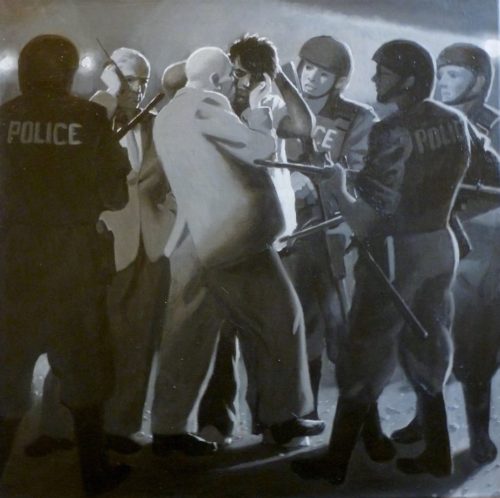
“Jesus is Arrested from “The Passion of Christ: A Gay Vision” (The Large Passion) by Doug Blanchard, 2023
Blanchard does show the Judas kiss in a second gay Passion of Christ series that he began in 2016 and completed in 2023. The new series features a darker, racially indeterminate Jesus who lives in a monochrome world until his resurrection.
___
Next: Day 4: Jesus before the priests and magistrate
or see the whole series “The Passion of Christ: A Gay Vision.”
The Passion series features 24 paintings by Douglas Blanchard, with text by Kittredge Cherry. It is also available as a book and prints.
Donate now to the 2025 Palm Sunday/Holy Week offering to support this series.
To read this article in Italian, go to:
Gesù e l’ultima cena, prega da solo e viene arrestato. La passione di un Cristo queer (gionata.org)
___
Top image credit:
5. The Last Supper (from The Passion of Christ: A Gay Vision) by Douglas Blanchard. Collection of Leslie-Lohman Museum of Gay and Lesbian Art. Gift of Vincent Palange in memory of Louis Prudenti.
___
This article was originally published on Q Spirit in April 2017, was expanded with new material over time, and was most recently updated on April 12, 2025.
Scripture quotation is from the Inclusive Language Lectionary (Year A), copyright © 1986 National Council of the Churches of Christ in the United States of America.
Scripture quotation is from the Inclusive Language Lectionary (Year C), copyright © 1985-88 National Council of the Churches of Christ in the United States of America.
Copyright © Kittredge Cherry. All rights reserved.
Qspirit.net presents the Jesus in Love Blog on LGBTQ spirituality.


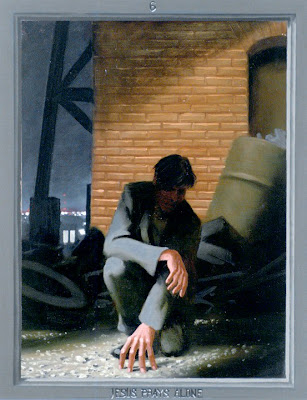

















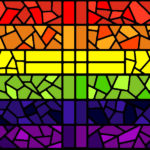

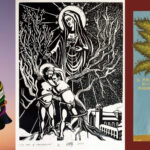

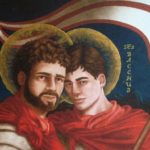
This article claims that the term “beloved disciple” “implies that Jesus was in love with him” and that the Bible “describes how the beloved rested his head on Jesus’ chest at the Last Supper”, which has been debunked on both points: the original language does not imply romance, and in fact the Bible also says Jesus “loved” Martha, Mary, and Lazarus and yet you never interpret that in romantic terms (except when it comes to Lazarus of course, but never Martha and Mary). You’re cherry-picking when to interpret this type of language as romantic. The idea that the “beloved disciple” was resting his head on Jesus’ chest is another case of misinterpreting the language and also the historical context : some historians have noted that the typical seating arrangements used for meals in that era would create a situation in which the only way John could look at Jesus while speaking would likely be to lean backwards in the direction of Jesus’ chest (not resting on the chest) since people usually ate while half-reclining on separate couches which were arranged in a semi-circle in a staggered pattern so that the closest people near Jesus would be either slightly in front and off to one side or slightly behind and off to one side, so if John was slightly in front then he would have to lean backwards while turning his head around. That doesn’t imply “snuggling” on Jesus’ chest.